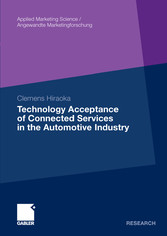Search and Find
Service
1 Introduction to Connected Services (p. 1)
1.1 “TAM Reloaded” or why it becomes ever more important
“Any customer can have a car painted any colour that he wants so long as it is black.” Remark of Henry Ford about the Model T in 1909, published in his autobiography My Life and Work (1922), Chapter IV
At the beginning of research on technology acceptance two decades ago, the degree of technology in our daily lives was quite limited: consumer electronics had just begun to get digitalized with the introduction of the Compact Disc in 1982, one year later Motorola introduced the first commercial “mobile” phone model “DynaTAC” at a weight of 0.8 kilogram and a dimension of 33x5x9 centimeters, and the Internet in the form of the World Wide Web was not even developed.
From that time to the present, two major trends have emerged for consumers and businesses, and need to be reflected when discussing technology acceptance: on the one hand, we see an increasing level of (digital) “technification,” and on the other hand, we recognize that the shift from the primary and secondary sectors to the tertiary, service sector is still developing.
Both trends are visible and valid for most industries, but in the automotive sector they are especially relevant and will become even more important in the future. The following three examples clearly demonstrate this development: the German research institute “Kraftfahrtwesen und Fahrzeugmotoren Stuttgart” predicts that electric and electronic features already account for 30% of the value creation of a middle class vehicle and will deliver 90% of the future automotive innovations (Grimm 2007).
Furthermore, the share of system innovations (i.e., innovations based on connected technologies and features) will rise compared to individual, singular innovations (Wyman 2007). To make these quite abstract figures more concrete, consider the number of available options increasing from 14 on a 1986 BMW 7 series to 92 options in the 2006 model (Wyman 2007) or the current VW Phaeton with 45 control units connected through 3.860 meters of cable at a weight of 64 kilograms (Grell 2003).
With regard to the sectors of the economy, industrialized countries today generate most of their gross domestic product from the service sector, e.g., reaching almost 70% in Germany 2007 (BMWI 2008). In this economic reality, companies in various industries are extending their value chain from hardware production into adjacent services.
Examples in the B2B sector can be found in the IT industry, where IBM – historically starting as a typewriter producer – nowadays generates 55% of its turnover from the services business unit (IBM Annual Report 2007, page 23), or in the energy sector, where wind energy producers move into the maintenance and repair business, even for windmills of other brands.
In the B2C sector, the automotive industry is once more a good case in point. At the very beginning, original equipment manufacturers (OEMs) only focused on the sales of their vehicles, and customers were welcome again only if they intended to buy a new one (see also the quote on customer orientation from 1909 at the beginning of this chapter).
This has obviously changed very much, and today 60% of revenues and 80% of profit of a vehicle over lifetime originate from the so-called downstream business, i.e., finance, insurance, accessories, maintenance/repair and fleet management (Dannenberg 2005, p.41). OEMs are trying to capture a significant portion of the after-sales, maintenance, and repair business through their own (or licensed) sales networks.
This shift from hardware sales to service is also reflected in the business models and their cash flow streams over time. OEMs are offering leasing to businesses and individuals – also increasingly through their own financial services departments – and bundle vehicles with all-in service contracts to gain repeat-customer contacts. In the most extreme form, examples from other industries like telecommunication providers become so-called “continuous service providers” (Bolton 1998), which generate revenues only as long as customers maintain the contractual relationship with the company.
Recently, however, entrepreneur and former SAP executive Shai Agassi transformed this concept in the automotive space by presenting his project “Better Place” for introducing electric cars to the Israeli market (Congress 2007, see also http://www.betterplace.com/). According to his plans, customers do not buy those vehicles, but finance the subsidized hardware through the purchase of batteries and electricity services only. This concept would represent the final shift from a hardware-selling OEM to a mobility solution provider.
All prices incl. VAT













